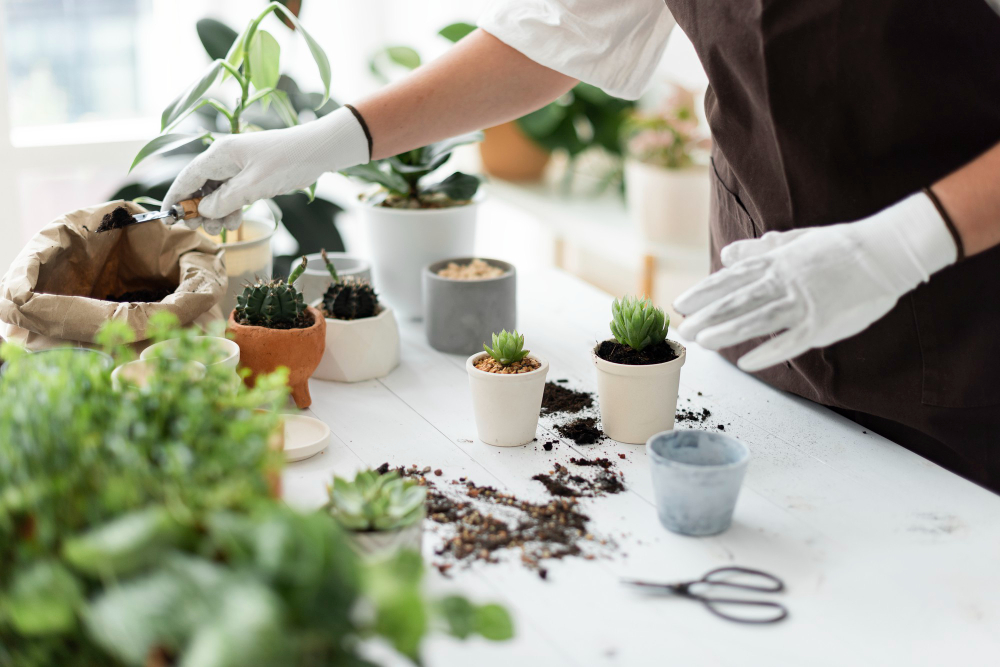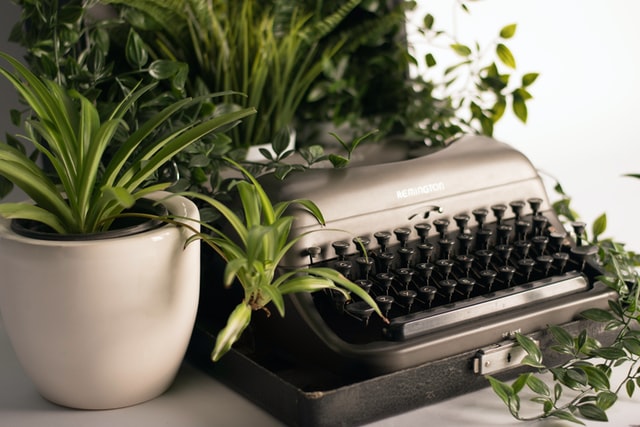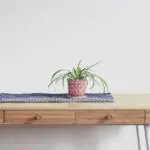Why is my spider plant pale and limp? It’s a question that I’m sure most of you have asked at least once in your life. And before I dive into this post (creative, huh!?), let me just say that Spider plants are such great indoor plants because they are so forgiving and easy to take care of. If you’re looking for decorative indoor plants for the office or home – Spider plants will not disappoint you.
Table of Contents
Why Is My Spider Plant Pale And Limp?
The leaves of a spider plant may turn a pale color or become limp if the plant has been overwatered, subjected to an excessive amount of light (indoors), allowed to become rootbound, is suffering from a nitrogen deficiency, has been damaged by frost or sunburn, or if there is an infestation of pests.
In case you were wondering, why is my spider plant pale and limp? Here’s your answer.
It’s generally one or more of the following five fairly common problems:
- Lack of light
- Excessive light
- Too little fertilizer
- Overwatering
- Repotting is required
We encourage you to continue reading regardless of which of the aforementioned factors you feel may be afflicting your spider plant. This article will provide a more in-depth explanation of each possible reason, as well as instructions on how to address each one. There is still a chance that you can save your spider plant, but you will need to move quickly. You don’t want to miss out on this!
Read more: The complete guide to repotting a spider plant
Problems that Make Spider Plants Look Pale and Limp Plus Quick Fixes

The spider plant, also known as Chlorophytum comosum, can have naturally occurring color variations that vary from one plant to the next. Your houseplant may be perfectly healthy while having leaves of a slightly lighter green color. You should be concerned only if the leaves appear very light, especially if this sudden change in color is followed by leaf tip browning and/or limping.
This article will explain what is causing these unwanted changes in your spider plant and what may be done to remedy the situation.
Read more: Why Spider Plant Leaves Bend?
Lack of light
Let’s play out a situation that many new indoor gardeners would recognize. You are excited about taking care of your spider plant when you get it home. You believe that you have located a suitable location for it in the far corner of your workplace or living room. There is a possibility that there is some light there, although the seasons fluctuate.
Because of this, the spider plant receives a far lower amount of light than it should. You are ignorant of any other options, so you choose to leave it as it is. After all, it’s not as if your houseplant has passed away or appears to be passing away, so what could possibly go wrong, right?
The issue with certain species of houseplants is that they have a tendency to be virtually tolerant of this type of behavior, despite the fact that it is not in their best interest. It is possible that you will not believe you are doing anything incorrectly because the spider plant may survive in dim to low light. In addition to this, it is not prospering. It’s not uncommon for growth to stall out, and it’s also likely that your plant may become leggy and pallid with age.
The Solution
Don’t feel terrible if your spider plant misled you into thinking it required low light. Due to this plant’s reputation for enduring less-than-ideal circumstances, many indoor gardeners give it too much latitude.
Because you now have more information, it is time to provide your spider plant with the lighting conditions that it has required from the beginning.
Spider plants can tolerate some direct sunlight, but you should check on them after they have been exposed to the sun for a few hours. For everyday maintenance, indirect light and somewhat shaded lighting conditions are preferable. That is twice, if not triplely, true; you cannot be home to relocate your plant after a few hours in direct sunlight.
Read more: How Do You Fix A Wilted Spider Plant?
Too Much Light
It’s possible that you slipped into the care regimen for your spider plant by accident. You left it in a bright place in your living room or bedroom one morning before leaving for the day. Because the plant appeared to be in satisfactory condition when you returned home, you continued to water it regularly for a considerable amount of time.
There has been a recent shift in the appearance of your spider plant. The previously vibrant and bright green color of the leaves has faded, and they now appear more white. The leaves have lost the rigidity and strength they formerly possessed, which has resulted in a drooping appearance. To make matters even worse, there are brown spots on several of the leaf surfaces.
As previously said, the spider plant is one of the more forgiving houseplant species in terms of lighting requirements. It will remain alive regardless of the amount of light present, from the dimmest to the brightest.
Although this indoor plant benefits from direct sunlight, too much of a good thing may rapidly become harmful. The sun has a tendency to burn your spider plant’s signature long leaves, resulting in brown blotches and tips. When these symptoms are also accompanied by pallor and a limp feeling, it indicates that something really serious has occurred.
The Solution
Although we like the sun’s warmth, prolonged exposure to its rays can be harmful to our skin. Your spider plant and its leaves are in the same boat. Keep in mind that it is preferable to offer light that is both bright and indirect in virtually all situations. This will give the plant the impression that it is receiving sun without exposing it to the sun’s full intensity. As was previously indicated, exposing your plant to a few hours of direct sunlight is permissible as long as you are present to observe it and remove it from the sunshine before it begins to char.
Read more: Why is my Spider Plant drooping?
Not Enough Fertilizer

If you’re just getting started in the world of gardening, the thought of fertilizing could make you feel a bit uneasy. You know from reading this site that certain house plants require different nutrition ratios than others. In addition to this, it appears that each one has a unique set of fertilizer requirements.
Because of this, you probably tried to limit the number of times each week that you fertilize your spider plant. You have owned the plant for a year and have fertilized it at least once, perhaps more. As was the case previously, your plant appeared to be working normally for some time, but its condition has recently begun to deteriorate. It’s having the same problems it had when you weren’t supplying enough light: your spider plant is pale and dead.
Read more: Why Are My Spider Plant Leaves Folding?
The Solution
The houseplant’s growing season is the one time of year you should build a fertilizing schedule around in the future. Your plant will require extra nutrients to maintain its growth at that point.
As is the case with the majority of houseplants, the spider plant experiences the greatest amount of growth throughout the months of spring and summer. You can fertilize your plants every two weeks during these seasons, or you can fertilize them considerably less frequently, like once a month.
Chlorophytum comosum can be fertilized with a variety of fertilizers, but during the warmer months, liquid fertilizer is the best option. Other types of fertilizer may also be used. If you do decide to establish a routine of fertilizing the plant once every two weeks, you need to be on the lookout for the accumulation of salt in the soil. This occurs on occasion, and when it does, it could have an effect on how well the plant absorbs water.
You can’t always notice salt if it penetrates deep enough into the soil. Because of this, getting rid of the contaminated soil is an almost impossible task. Instead, it is preferable to completely renew the soil and apply fertilizer on a somewhat less frequent basis going forward.
You may try growing your spider plant with a variety of different types of fertilizer, including liquid fertilizer, pellet fertilizer, inorganic fertilizer, and organic fertilizer.
When looking into different kinds of fertilizer for your spider plant, here is a quick rundown of each that will provide you with the information you need to make a more educated decision.
- Pellet fertilizer: a yearly treat for houseplants such as spider plants, pellet fertilizer is applied directly to the soil. It then begins to function gently, causing your plant to grow.
- Inorganic fertilizer: Certain inorganic fertilizers include chemicals that may be harmful to your houseplant if it comes into contact with them. There is also a possibility that pests, such as insects and small critters, will make their way inside your spider plant. If you must use it, only do so for extremely brief durations.
- Organic fertilizer: When deciding between organic and inorganic fertilizers, in my opinion, organic fertilizer is the superior choice. It does not include the chemicals that are frequently present in inorganic fertilizers, and it also has a lower concentration of salt that might leach into the ground. Even if you fertilize your plant every few weeks, the answer is still yes.
Overwatering
Watering houseplants is one of the most common mistakes made by indoor gardeners. A houseplant that is underwatered is unhappy, but one that is overwatered is practically drowning, so it is in far worse shape.
The Solution
If the leaves of your spider plant begin to lose their color, appearing almost as if they have been bleached, this is a sign that the plant needs less water. In some instances, the edges of the leaves could have a dark-colored appearance. In any case, you should significantly reduce the amount of watering you do and only get into the habit of doing so when the soil appears to be mainly dry.
Read more: Why Are My Spider Plants Leaves Curling?
Grown in the same pot for too long.
If your spider plant is still looking pale and lifeless after you’ve addressed the above concerns, there’s one more thing to try. That is how frequently you should repot your houseplant.
Your spider plant and other healthy houseplants should eventually outgrow their containers if they are kept inside. If anything like this occurs, if you don’t immediately shift it to a larger setting, you might find yourself in a problematic situation. Because the plant has nowhere to expand to, it is at risk of becoming weak and floppy as a result. It’s possible that the roots of your spider plant may grow through the drainage holes in the container, which will make them weaker and negatively impact the plant’s appearance.
The Solution
It is strongly suggested that you repot your spider plants about once per year. You most certainly do not need to repot your plants exactly once a year, but you should use some judgment in this matter. It is possible that you have waited too long if you observe problems. such as the plant’s growth becoming stunted or roots becoming apparent through the drainage holes in the container.
When you repot your spider plant, it will express its gratitude to you. Because the plant has grown excessively top-heavy, you are now preventing avoidable hazards such as spills and tumbles. In addition to this, you can maintain the high quality of the soil throughout the year. When fertilization causes the soil to become affected or penetrated with salt, the soil loses some of its ability to aerate properly. This results in the roots of your spider plant receiving less water, which puts the plant in jeopardy.
Read more: Should I Cut Bent Spider Plant Leaves?
Conclusion
Why Is My Spider Plant Pale And Limp?
Here are some pointers on how to revive a pale and limping spider plant.
- Do not let the plant dry out.
- Overwatering is far more likely to cause it to go limp.
- If you aren’t sure whether or not your spider plant needs to be watered, you should wait a few days before inspecting it again, and err on the side of caution by not watering it;
- To prevent the roots and stems of the pot from decaying, ensure that there is adequate air circulation around the pot.
- If they appear damp, consider removing part of the leaves to allow new ones to develop in their place.
- It might potentially be suffering from a nitrogen deficit as a result of too many recycling waterings from untreated tap water.
- Applying some organic fertilizer to the soil on a regular basis will produce the best effects. Its drooping leaves ought to perk up as a result of this.
Photo by Shelby Miller on Unsplash
House plant photo created by rawpixel.com – www.freepik.com
Indoor plants photo created by rawpixel.com – www.freepik.com



